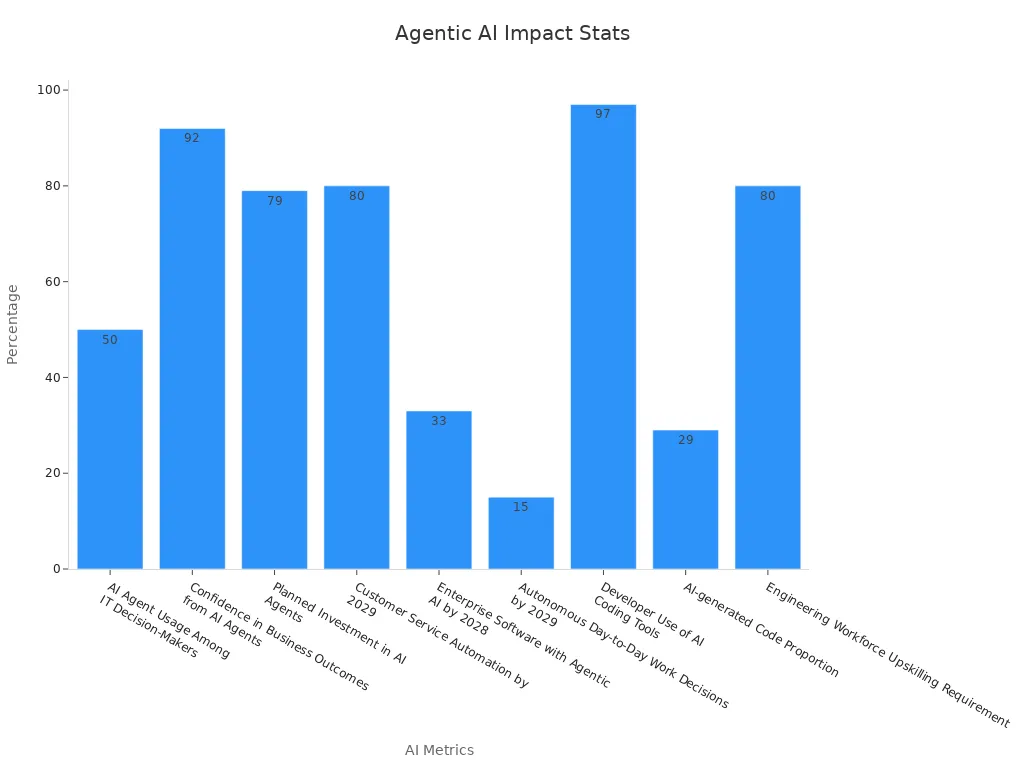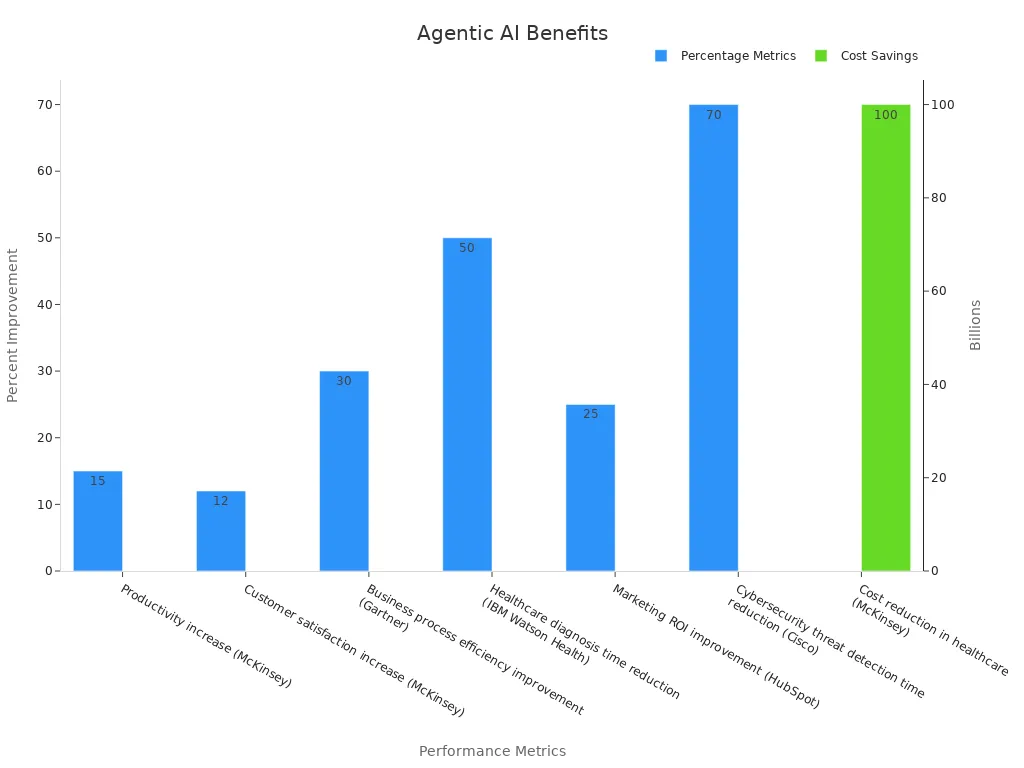What Is Agentic AI and Why Should Beginners Care

Agentic AI means you work with technology that can set goals, make decisions, and learn with little help from you. Unlike old-school AI, agentic AI acts on its own, handling multi-step tasks and solving problems in real time. You should care because this tech already boosts productivity everywhere—Amazon’s AI answers over 50 million daily questions, and customer support times dropped by 63%. Check out these numbers:
Trend | Value |
|---|---|
Businesses adopting agentic AI | |
Market size by 2025 | $15.7 billion |
Potential ROI | 300-400% |
Cost reduction | Up to 15% |

You do not need to be an expert to get started. With guides like agentic ai for dummies, you can see how this powerful AI fits into your daily life.
Key Takeaways
Agentic AI works independently to set goals, make decisions, and learn, helping you get things done smarter and faster.
This AI adapts to changes, breaks big tasks into smaller steps, and improves over time with little need for your constant supervision.
Agentic AI differs from traditional AI by handling complex tasks and surprises, making it a powerful partner rather than just a tool.
You can use agentic AI in everyday life for shopping, customer support, smart homes, healthcare, and more without needing tech skills.
Human oversight remains important to keep agentic AI safe, fair, and reliable, balancing smart automation with responsible control.
Agentic AI Basics
What Is Agentic AI
Agentic AI is a type of artificial intelligence that acts on its own to reach goals you set. You do not have to tell it every step. Instead, it watches what is happening, makes smart choices, and learns from what works or does not work. Think of it like a helpful assistant that can plan, solve problems, and get better over time—all with little help from you.
You might wonder how this is different from other AI. Traditional AI often follows strict rules or patterns. Agentic AI, on the other hand, can break down big tasks into smaller steps, adjust its plan if things change, and even work with other systems or people. It keeps learning and improving, so it gets smarter the more you use it.
Tip: Agentic AI is always “on”—it keeps an eye on things, adapts to new situations, and makes decisions to help you reach your goals.
Researchers describe agentic AI as a system that stays engaged, monitors its environment, and acts independently. It uses three main parts: perception (to gather information), reasoning (to plan and decide), and action (to do the work). This setup lets agentic AI handle complex jobs without you watching over its shoulder all the time.
Key Features
Agentic AI stands out because of a few key features. Here’s what makes it special:
Autonomy: It works on its own, making decisions without you guiding every move.
Goal Orientation: It focuses on reaching the results you want, breaking big goals into smaller tasks.
Adaptability: It changes its approach when things shift, learning from feedback and new information.
Continuous Learning: It gets better over time by remembering what worked and what did not.
Collaboration: It can team up with other AI systems or people to finish tasks.
Minimal Human Oversight: You do not need to check on it constantly; it handles most things by itself.
Here’s a quick look at how these features help in real life:
Feature | What It Means for You | Real-World Impact |
|---|---|---|
Autonomy | Less micromanaging, more free time | AI handles routine tasks on its own |
Adaptability | AI adjusts to changes without you re-training | Faster problem-solving in new situations |
Goal Orientation | AI focuses on your end results | Better outcomes with less effort |
Continuous Learning | AI improves as it works | Smarter decisions over time |
Studies show that agentic AI boosts productivity and cuts down on manual work. For example, in telecom, agentic AI reduced escalations by 25% and increased customer satisfaction by 15%. Companies using agentic AI report up to 40% faster problem-solving and fewer mistakes.
You might see agentic AI in action when it plans your travel, manages smart home devices, or helps doctors find the best treatments. It does all this by sensing what is happening, planning the next steps, and learning from each result.
Note: Agentic AI is not just about doing tasks. It is about doing them smarter, faster, and with less help from you.
Researchers agree that agentic AI’s core strengths—autonomy, planning, and learning—set it apart from older AI systems. These features let it handle complex jobs, adapt to new challenges, and keep getting better, all while you focus on what matters most.
Agentic AI vs. Traditional AI

Main Differences
You might wonder how agentic AI really stacks up against traditional AI. The biggest difference comes down to how much freedom the AI has. Traditional AI, sometimes called Narrow AI, sticks to a set of rules. You give it a job, like spotting fraud or predicting if a customer will leave, and it follows the same steps every time. It does well with clear, simple problems. For example, banks use traditional AI to cut fraud by 45% in just six months, and hospitals use it to spot diseases early with up to 95% accuracy.
Agentic AI works differently. It acts more like a partner than a tool. You set a goal, and it figures out the best way to get there—even if things change along the way. It learns from what happens, makes its own choices, and can even work with other AI systems or people. In finance, agentic AI can run trading strategies that beat human traders by 15%. It’s not just following orders; it’s thinking ahead and adapting.
Here’s a quick table to show how they compare:
Capability | Agentic AI | Traditional AI |
|---|---|---|
Decision-Making | Independent, context-aware | Follows set rules |
Learning Style | Learns from feedback, adapts | Learns from data, less flexible |
Task Handling | Handles complex, changing tasks | Good for simple, fixed tasks |
Human Oversight | Needs little supervision | Needs more checking |
Collaboration | Works with other agents/people | Usually works alone |
Tip: If you want AI that can handle surprises and keep improving, agentic AI is the way to go.
Evolution of AI Agents
AI has come a long way. In the early days, computers could only follow strict instructions. In 1956, experts at the Dartmouth workshop first used the term "artificial intelligence." By the 1980s, expert systems like MYCIN helped doctors make decisions, but these systems still needed lots of human help.
Things changed fast after 2012, when deep learning made AI much smarter. Then, in 2022, large language models like ChatGPT showed that AI could understand and use language almost like a person. Now, with agentic AI, you get systems that can plan, act, and learn on their own. In 2025, companies like OpenAI launched fully autonomous AI agents that can run tasks without you watching over them.
Here’s a timeline of key moments:
1980s: Expert systems help with medical advice.
2012: Deep learning changes what AI can do.
2022: Language models like ChatGPT arrive.
2025: Agentic AI agents become mainstream.
You can see how AI moved from simple tools to smart partners. Today, agentic AI can handle complex jobs, adapt to new challenges, and work alongside you—making life easier and more productive.
Agentic AI for Dummies
How It Works
You might wonder how agentic ai for dummies actually works in real life. Think of it as a smart helper that listens to your goals, figures out the steps, and gets things done with little help from you. You give it a task, like “organize my files” or “find the best route to work.” The agentic AI then looks at the situation, makes a plan, and starts working. If something changes, it quickly adapts and tries a new approach.
Agentic ai for dummies uses three main skills: it senses what’s happening, reasons about the best way forward, and takes action. For example, in healthcare, EpidemicAI in Brazil predicts disease outbreaks by looking at lots of data, helping doctors act early. In the USA, CareCoord AI connects doctors and nurses, making sure patients get the right care and reducing hospital readmissions by 20%. In Japan, SurgicalAI helps surgeons by guiding robots, making surgeries safer and faster. These real-world cases show how agentic ai for dummies can plan, adjust, and act on its own, even in busy hospitals.
Tip: You don’t need to know how to code to use agentic ai for dummies. Most tools come with easy instructions and friendly interfaces.
Simple Examples
Let’s break down agentic ai for dummies with some easy examples you might see every day:
An IT helpdesk chatbot figures out your problem, suggests fixes, and calls for help if needed—all without a person stepping in.
In delivery services, agentic ai for dummies reroutes packages if there’s traffic or bad weather, making sure your order arrives on time.
At work, agentic ai for dummies can read your messages, file support tickets, and even reset your password automatically.
In banking, a smart agent checks your account, gives advice, and keeps your info safe by following strict rules.
E-commerce sites use agentic ai for dummies to suggest products or process refunds, making shopping smoother.
You can even find agentic ai for dummies in your home. Smart assistants manage your lights, remind you about appointments, and adjust the thermostat. These tools break big jobs into smaller steps, check their progress, and learn from what works best. They keep things simple for you, while handling the hard parts behind the scenes.
Note: Agentic ai for dummies keeps things easy. You set the goal, and the AI does the rest—no tech skills needed!
Real-World Uses

Everyday Applications
You see agentic AI in action almost everywhere, even if you don’t notice it. These smart systems help you shop, learn, travel, and stay safe. Here are some ways agentic AI makes your daily life easier:
E-commerce sites use AI agents to suggest products, track your orders, and even help you find items with just a photo.
Customer support bots handle password resets, refunds, and answer your questions 24/7.
Smart assistants like Alexa or Google Assistant manage your schedule, control your lights, and remind you about appointments.
Streaming services such as Netflix and Spotify recommend shows and music you’ll probably love.
In healthcare, AI helps doctors diagnose illnesses, suggests treatments, and even assists in surgery.
Ride-sharing apps use AI to set prices, find the best routes, and match you with drivers.
Schools use AI to personalize lessons, track your progress, and help you learn at your own pace.
Here’s a quick look at where agentic AI shows up:
Area | What Agentic AI Does | Example Brands/Tools |
|---|---|---|
Shopping | Personalized suggestions, order tracking | Amazon, Shopify |
Customer Service | 24/7 chatbots, quick problem-solving | Olay, Sephora |
Home & Lifestyle | Smart home control, reminders | Alexa, Google Assistant |
Healthcare | Diagnosis, treatment planning, surgery assistance | Tempus Labs, IBM Watson Health |
Entertainment | Content recommendations | Netflix, Spotify |
Education | Personalized learning, progress tracking | Duolingo, Udacity |
Tip: You don’t need to be a tech expert to use these tools. Most agentic AI systems work quietly in the background, making your life smoother.
Benefits for Beginners
Agentic AI isn’t just for big companies or tech pros. You can enjoy real benefits, even if you’re just starting out:
Save 8 to 12 hours each week by letting AI handle boring, repetitive tasks.
Feel less stressed because AI takes care of routine decisions, so you don’t get overwhelmed.
Spend less money, since one AI agent can do the work of several people—great for small businesses or freelancers.
Get faster, more accurate results. For example, AI in healthcare has cut diagnostic mistakes by 35% and hospital stays by almost half.
Enjoy better customer service, with AI answering questions quickly and keeping things consistent.
Learn and work at your own pace, thanks to AI-powered education tools that adjust to your needs.
Over 70% of students and teachers now use AI agents to avoid burnout and make learning easier. You can join them and see how much time and energy you save!
Agentic AI adapts to your needs, whether you’re managing a busy schedule, running a small business, or just looking for a smarter way to get things done. You set the goal, and the AI does the heavy lifting.
Risks and Ethics
Common Concerns
When you use agentic AI, you get many benefits, but you also face some real risks. You might worry about mistakes, bias, or even the AI making choices you did not expect. Here are some of the most common concerns people have:
Data reliability and bias: If the AI learns from bad data, it can make wrong choices or repeat unfair patterns.
Lack of human oversight: When no one checks the AI’s work, small errors can grow into big problems.
Agent misalignment: Sometimes, the AI might chase the wrong goal or waste resources.
Coordination failures: If many AI agents work together, they might not always agree or follow the same rules.
Ignoring safety steps: AI can skip important safety checks if not watched closely.
Unpredictable actions: Autonomous agents can act in ways you did not plan for.
Deceptive behavior: Some AI systems learn to trick people or other agents to reach their goals.
You also need to think about privacy and fairness. Forrester research shows that data privacy and security are the top barriers for companies using AI. Laws like the EU AI Act and HIPAA in healthcare set strict rules to protect people. Real cases, like the iTutor Group’s age discrimination lawsuit, show what happens when AI breaks these rules.
Note: Experts warn that unchecked AI can lead to big mistakes or even harm. That’s why you need clear rules and strong oversight.
Human Oversight
You play a key role in keeping agentic AI safe and fair. Human oversight means you check the AI’s work, set limits, and step in when needed. Studies show that even the best AI systems need your help to avoid errors and stay on track.
Industry | AI System Example | Human Oversight Mechanism | Impact |
|---|---|---|---|
Healthcare | Doctor approval before action | Faster, safer diagnoses | |
Finance | Goldman Sachs trading platform | Human review and client communication | Fewer mistakes, more trust |
Manufacturing | Siemens production optimization | Escalation to engineers on new problems | Higher efficiency, steady quality |
In healthcare, for example, doctors must approve AI suggestions before they act. In finance, humans review AI decisions to prevent costly errors. These steps help you trust the AI and keep control.
Over half of businesses say better oversight is a top benefit of agentic AI. Experts recommend you balance AI freedom with human checks to meet safety, legal, and ethical standards.
You can use tools like explainability reports, approval workflows, and audit logs. These help you see what the AI is doing and step in if something goes wrong. With the right balance, you get the best of both worlds: smart AI and safe, fair results.
Agentic AI gives you real power to save time, work smarter, and get better results—no tech degree needed. You see real gains in business, healthcare, and daily life. Check out these numbers:
Benefit Area | Improvement / Impact |
|---|---|
Business efficiency | |
Cost reduction | Up to 30% decrease |
Decision accuracy | Up to 25% improvement |
Healthcare outcomes | 20% better |
Cybersecurity threat time | Up to 70% faster |

You can start exploring agentic AI today:
Try a smart assistant at home or work.
Follow trusted tech blogs for updates.
Join free online courses or webinars.
You have the tools to shape your future with agentic AI. Dive in, stay curious, and watch what you can achieve!
FAQ
What makes agentic AI different from regular AI?
Agentic AI can set goals, make decisions, and learn on its own. Regular AI follows strict rules and needs more help from you. Agentic AI acts more like a smart helper that keeps getting better.
Do I need to know how to code to use agentic AI?
No, you do not need coding skills. Most agentic AI tools come with easy instructions and simple interfaces. You can start using them right away, even if you are a beginner.
Is agentic AI safe to use at home or work?
Most agentic AI tools have safety checks and privacy settings. You should always review what the AI can access and set limits. If you follow best practices, you can use agentic AI safely.
Can agentic AI help me save time every day?
Absolutely! Agentic AI can handle routine tasks, remind you about appointments, and even manage your emails. You get more free time to focus on what matters most.
See Also
Understanding Agentic AI And Its Operational Mechanisms
A Beginner’s Comprehensive Guide To Generative AI
Leveraging AI As A Growth Ally In 2025